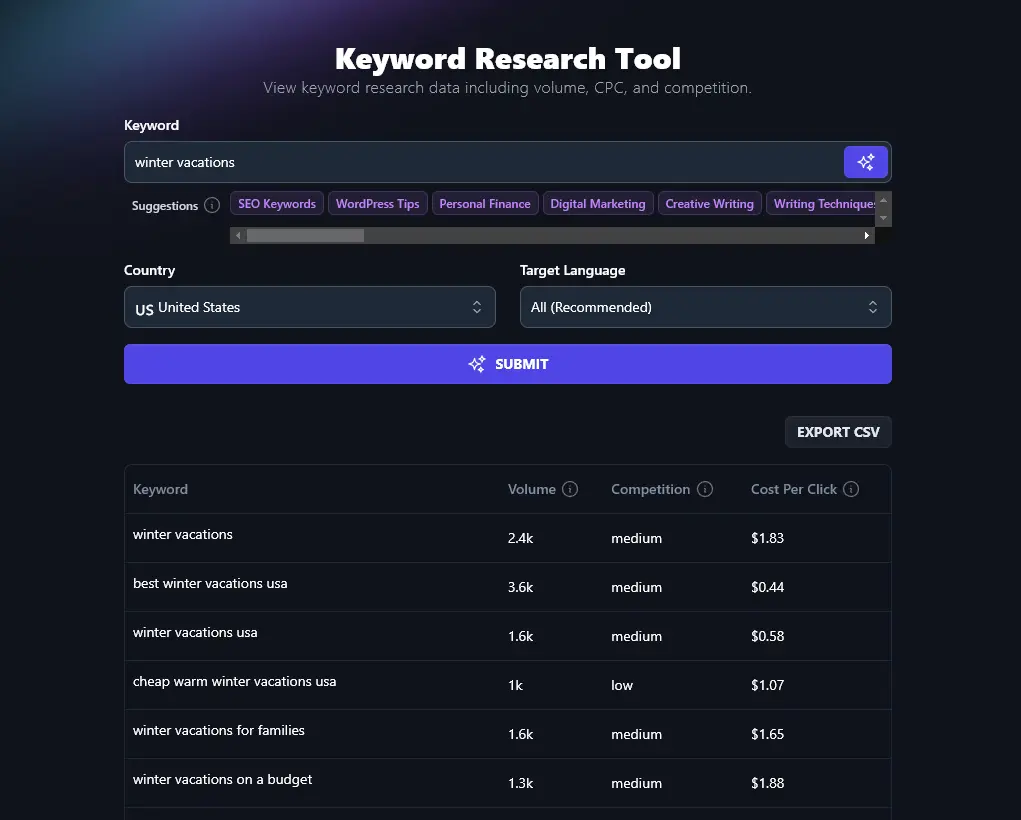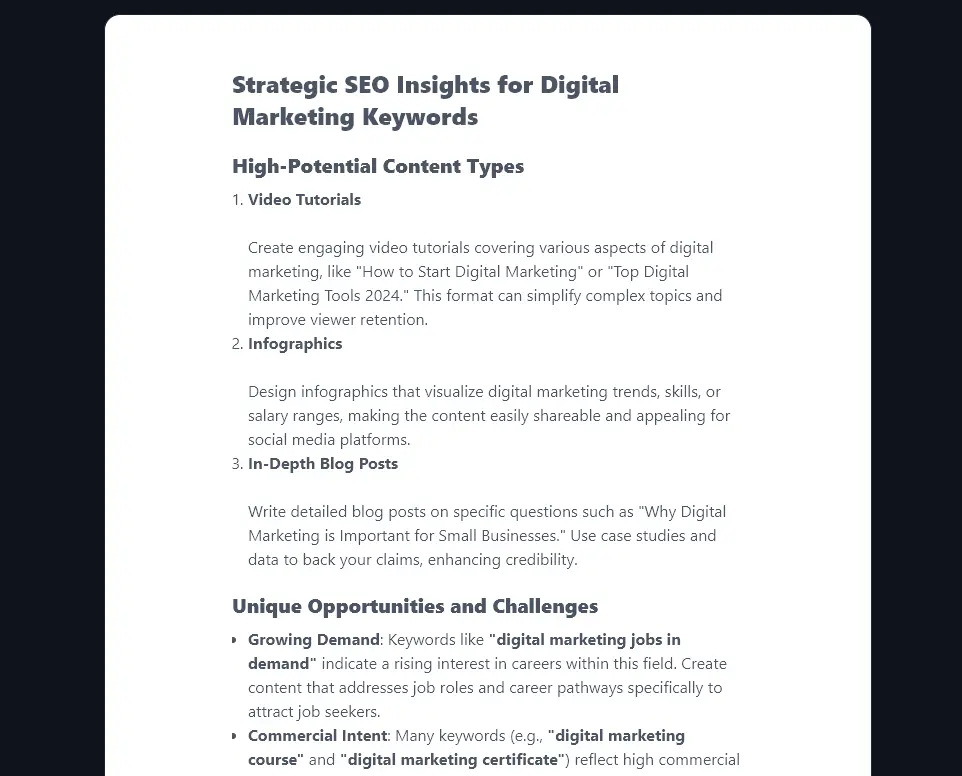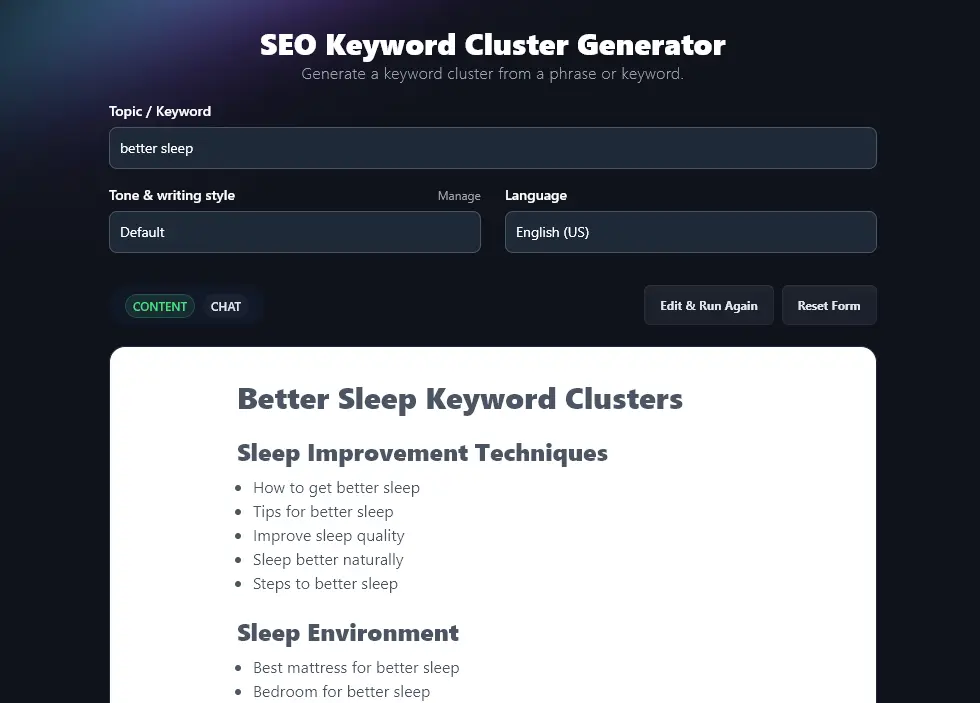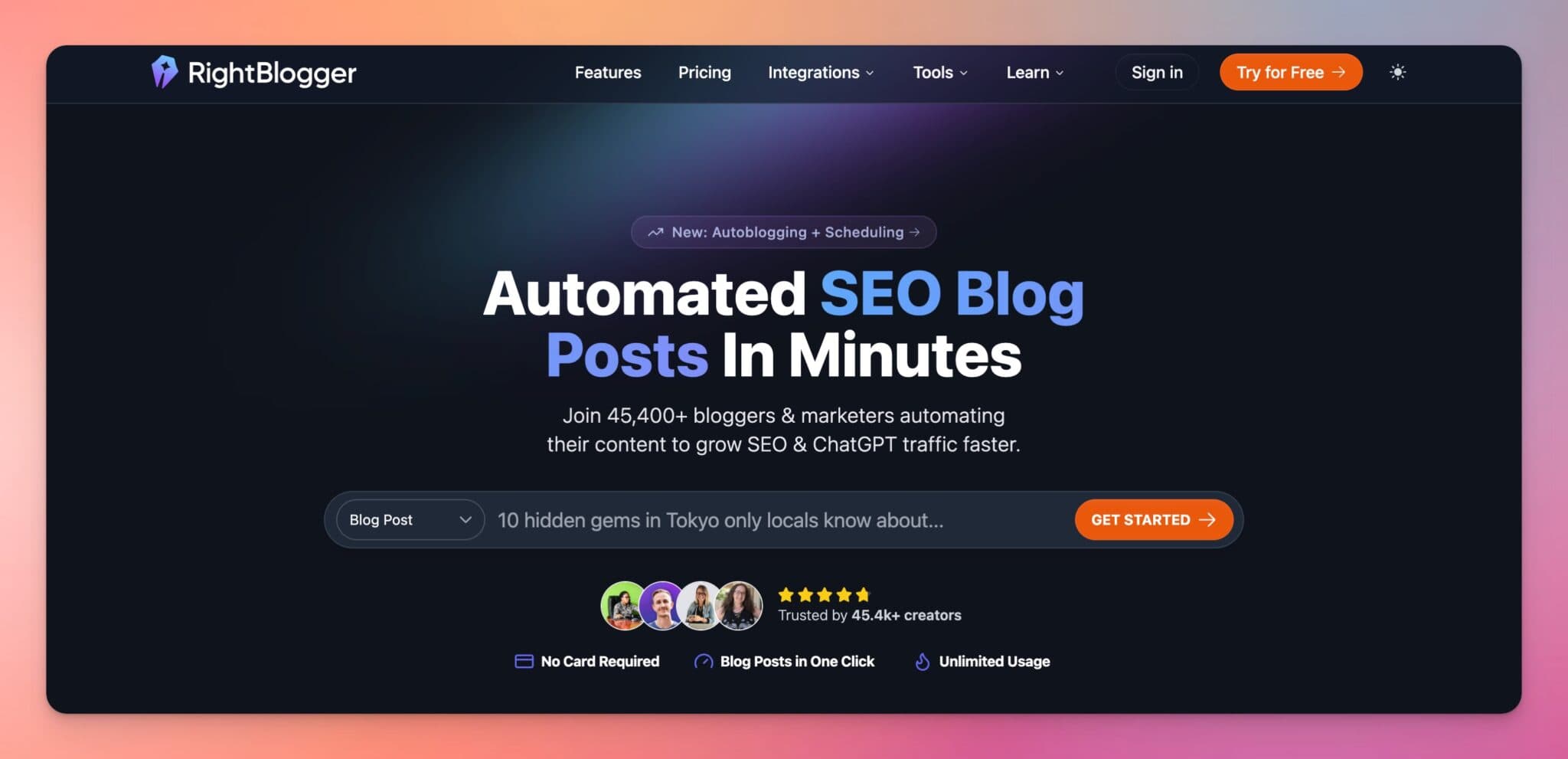9 Free AI SEO Tools to Get More Traffic (Easy to Use)

If you want your content to rank higher in search results, it helps to have the best free AI SEO tools at your fingertips. Getting your content discovered (and ranked high) on Google, requires solid on-page SEO. Thankfully, this is one area where AI is particularly useful today.
The best news is, this type of SEO—the things you can do to tune up your own content—is fully in your control. And you can do it faster using RightBlogger’s free AI SEO tools.
For each tool we take for a spin in this guide, I’ll show you how it works—and give you some actionable tips on getting the most out of whichever AI SEO tools you choose to use in your process.
Before You Start: Make Your Free RightBlogger Account
To access these free AI SEO tools, you’ll need a free RightBlogger account. If you haven’t already, go ahead and sign up now, it takes just a few seconds and you don’t need to enter any credit card info.
You can sign up using a Google account, or you can pop in your email address and a password of your choice.

Once you’ve signed up, you’ll need to confirm your email address. After you’ve done that, let’s have some fun.
You’ll see some of our top tools, along with links down the left hand side for all our AI tools (85 and counting). This menu also lets you easily browse the tools—the free AI SEO tools are all organized into one handy section—or you can use the search field at the top of the page to find a tool, anytime.

Now, let’s get into our breakdown of all my favorite free AI SEO tools inside RightBlogger.
9 Free AI SEO Tools in RightBlogger (to Get More Google Traffic)
All the tools we’ve built are easy and intuitive to use, so you can quickly improve your SEO without the need for technical skills. These AI SEO tools are specially designed for bloggers, content creators, marketers, and small business owners who wanna get more organic traffic to their sites.
1. Keyword Research Tool
Start the content creation process with our keyword research tool. This lets you pinpoint the perfect keywords to optimize a (new or existing) piece of content around.
Enter a primary keyword phrase or topic and this AI-powered SEO tool will come up with a wide range of related keywords for you to consider creating content about—along with their monthly search volume and difficulty ratings, so you can make an informed decision about which ones to pursue.
Here’s how that looks:

You can sort the results by clicking on the column headers, or you can download them as a .csv file. Note that on the free plan, you’ll only get 25 results from each keyword search—if you’d like more, just upgrade to our Unlimited plan.
Tip: Choose keywords with “low” difficulty and, ideally, 1,000+ monthly searches. These will be fairly easy to rank for and should bring in a lot of traffic.
2. People Also Ask Tool
Struggling to come up with potential keywords to feed into the Keyword Research Tool? Maybe you’re looking to solve some sticky problems for your target audience?
The People Also Ask tool digs into Google’s autocomplete data, figuring out exactly what real Google search users are looking for answers about—making this a great way to uncover real pain points to address in your overall digital marketing playbook.

This free AI SEO tool also gives you a full strategic guide to crafting content around these search terms, helping you make sure you optimize content to match search intent. If you’re looking to create a complete SEO strategy, this can give you a massive head start.

Tip: You can use this tool along with the Keyword Research Tool to dig into the stats for different keywords. Just click on any keyword to instantly load it up within the Keyword Research Tool.
3. Meta Title Tool
When someone searches Google, they’ll see a limited amount of information about your content before deciding whether or not to click through:

The most prominent part of this is the meta title or SEO title for the content, which shows up in large blue clickable text. This needs to grab the reader’s attention—and it also needs to let both readers and search engines know that your content is super-relevant, so your primary keyword should go in your meta title.
The meta title tool helps you craft a great SEO-friendly and reader-friendly title, giving you 5 options to choose from:

Tip: Your meta title might be exactly the same as your H1 header on the page … but it doesn’t have to be. (They should be similar, though, to avoid confusing the reader.)
4. Meta Description Tool
Just below the meta title in search results comes the meta description. This will be around 150 to 160 characters of text that needs to (a) grab the reader’s attention and (b) incorporate your primary keyword phrase.
Our free AI meta description tool will give you 5 great options to pick from:

Tip: You can also use the meta description tool to craft meta descriptions for your existing blog posts—saving a ton of time if you’ve got lots of old posts to optimize.
5. Permalink Tool
Every piece of content you publish on your blog has a permalink—a permanent link to that individual post. You’ll want to strategically craft this to incorporate your keywords, without it being too long and unwieldy.

Tip: Often, it makes most sense to use your keyword as your permalink … but if you want more options or you haven’t yet settled on a keyword, this tool is a great way to get some strategic variations to consider.
6. Image Caption Tool
Including images in your blog posts is great for readers (as it breaks up text and can illustrate key points) … and great for your SEO too, if you do it right. That means having alt text for every image in your post.
Image alt text is useful for visually impaired users, and it also helps signal to Google what your post is about. The Image Caption tool can understand images and write great captions for them, making this a sneakily useful free AI SEO tool. For content optimization, we recommend using the ALT text option.

Tip: To make sure the AI incorporates your keyword, use this prompt in the Additional Information section:
7. Content Gap Analysis Tool
This tool is admittedly a little more involved—but it can have incredible results for your improving the performance of your existing content.
Our free Content Gap Analysis Tool lets you compare a piece of your content with a high-ranking competitor’s content that goes after the same keyword phrase. This free AI SEO tool will tell you exactly where your content is falling short… and pinpoint (based on the competitor) what to do about it.

Tip: Haven’t yet written your piece yet? Run the content gap tool for the top-performing result vs the second or third result to see what you could do to beat them.
8. Keyword Cluster Tool
One smart way to improve your overall site-wide SEO, is to create a range of useful content around a “cluster” of keywords.
This strategy lets you create many individual pieces helpful content that can be interlinked together, digging deep into topics with individual posts that are grouped by topic, and building your site’s authority for a series of long-tail keywords that’ll have less competition.

Tip: Want to start fleshing out each idea into a potential blog post? If you have the Unlimited version of RightBlogger, click the Chat button above your keyword clusters.
RightBlogger Chat works in a similar way to ChatGPT, with some additional data sources plugged in, so you can simply ask it something like:
9. Google Title & Description Preview Tool
We covered how to generate meta titles and meta descriptions above—but before publishing your post, you might want to check how these appear in Google. Maybe you’re concerned a word might get cut off, for example.
The Google Preview Tool lets you preview how your SEO content will look in Google’s search results.

Tip: Use this tool to edit and tweak your meta titles and descriptions, e.g. if you want to add a few more words to fill up the available space.
AI SEO Trends (to Stay Ahead of Google in 2025)
SEO evolves quickly, and keeping up can feel overwhelming. Thankfully, AI tools make adapting to new trends much easier, especially when it comes to major changes Google makes to its algorithm.
Here’s what you should be watching in 2025:
- Google’s Generative Search Experience: Google continues enhancing search with AI with GSE and even AI Mode, delivering results in a more conversational way. To capitalize on this, optimize your content around clear user intent and questions your readers actually ask.
- Algorithm Updates & Ranking Fluctuations: Google’s algorithm updates are becoming more frequent—and impactful. AI-driven tools help monitor these updates, track ranking fluctuations, and quickly adjust your content strategy to maintain your organic traffic.
- Emerging Marketing Strategies: AI now assists in uncovering emerging keyword trends, making it easier than ever to spot fresh opportunities early. Tools that track organic click trends can show you exactly what readers are clicking on today, so you can pivot quickly.
- AI-Generated Content Quality: Google is becoming increasingly sophisticated in identifying AI-generated content. Granted the real issue comes when you make dry content that doesn’t connect with a reader. Your content must feel authentic and add real value. AI writing assistants are great—but always add your personal touch to stand out and ensure your content stays human-first. That’s why in RightBlogger we made MyTone and options like the additional instructions field so you can get articles that perfectly match your spin on things.
Recap: Use Our Free AI SEO Tools to Boost Your On-Page SEO Fast
All the AI-powered tools we’ve covered above are free to use. Sign up today for your free RightBlogger account—just a few small tweaks to your on-page SEO could make a big difference to your search engine visibility.
If you find you’re running up against the free plan’s limits or you want access to our more advanced features, you can upgrade to an Unlimited plan. This costs just $29.99/month ($24.99 if you pay upfront annually) for full access to every single one of our tools—no credits or limitations.
Create Automated SEO Blog Posts in Minutes with RightBlogger

Join 45,417+ bloggers, creators, marketers, writers, & business owners in using RightBlogger’s powerful autoblogging tools. You’ll unlock 80+ blogging, SEO, and marketing AI tools to create content faster & more effectively today. Plus, you’ll access our library of courses, a private community, Tool Studio’s AI lead magnet builder, and more.
How should I use these free AI SEO tools together to plan a new blog post?
Start by using the Keyword Research Tool to find a main keyword with low difficulty and solid search volume. Then plug that topic into the People Also Ask tool to uncover real questions people type into Google.
Next, use the Keyword Cluster Tool to map out related long-tail keywords you can cover in separate sections or future posts. This gives you a simple content plan that targets one main keyword and several supporting topics.
Once your outline is ready, write your post and then use the Meta Title, Meta Description, and Permalink tools to optimize the basics. Finally, check how it will look in search using the SERP Preview Tool so you can tweak your title and description for more clicks.
Can RightBlogger help me write SEO friendly blog posts from scratch, not just optimize them?
Yes, RightBlogger can help you create full blog posts that are already SEO focused. You can start your draft with the RightBlogger AI Article Writer using your target keyword and a short description of your topic.
After the draft is created, you can adjust the tone with features like MyTone so the content matches your voice and audience level. This keeps your posts feeling human and personal while still using AI for speed.
From there, you can plug the post into tools like the Meta Title, Meta Description, and Image Caption generators to polish your on-page SEO. If you want to publish on a schedule, RightBlogger’s autoblogging and scheduling features help you keep a consistent posting rhythm without doing everything manually.
How do I know which keywords are worth creating a full content cluster around?
Start by running several ideas through the Keyword Research Tool and look for topics that have low or medium difficulty and at least a few hundred searches per month. These are often easier wins for newer or growing blogs.
Next, take a strong keyword and put it into the Keyword Cluster Tool to see related long-tail keywords. If you get a lot of clear, useful ideas that fit your niche, that is a good sign it can support a full cluster.
Over time, track how posts from that cluster perform using basic SEO metrics or reports, such as the ideas covered in RightBlogger’s guide to SEO reporting best practices. If the cluster starts bringing steady traffic, keep adding more helpful posts around that topic.
How can I use the Content Gap Analysis tool to improve old posts that are not ranking well?
First, pick a post that is targeting a clear keyword but is stuck on page 2 or lower in Google. Find a top ranking competitor for that same keyword, then run both URLs through the Content Gap Analyzer.
The tool will show you what your competitor covers that you do not, such as missing sections, examples, or key questions. Use those insights to update your post with deeper, more complete answers that match search intent.
After updating, optimize your meta title and description again so they better reflect the improved content. Over the next few weeks, watch for ranking and traffic gains, and repeat this process on other older posts to steadily lift your whole site.
Article by Ryan Robinson
RightBlogger Co-Founder, Ryan Robinson helps 500k readers use AI and smart SEO to grow online businesses as a recovering side project addict.
New:Autoblogging + Scheduling
Automated SEO Blog Posts That Work
Try RightBlogger for free, we know you'll love it.
- No Card Required
- Blog Posts in One Click
- Unlimited Usage





Leave a comment
You must be logged in to comment.
Loading comments...